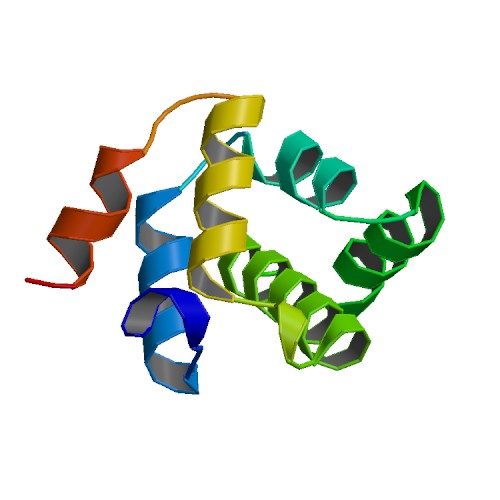CRADD
| CASP2 and RIPK1 domain containing adaptor with death domain | |||||||||||||
|---|---|---|---|---|---|---|---|---|---|---|---|---|---|
 PDB rendering based on 2o71. | |||||||||||||
| |||||||||||||
| Identifiers | |||||||||||||
| Symbols | CRADD ; MGC9163; RAIDD | ||||||||||||
| External IDs | Template:OMIM5 Template:MGI HomoloGene: 2821 | ||||||||||||
| |||||||||||||
| Orthologs | |||||||||||||
| Template:GNF Ortholog box | |||||||||||||
| Species | Human | Mouse | |||||||||||
| Entrez | n/a | n/a | |||||||||||
| Ensembl | n/a | n/a | |||||||||||
| UniProt | n/a | n/a | |||||||||||
| RefSeq (mRNA) | n/a | n/a | |||||||||||
| RefSeq (protein) | n/a | n/a | |||||||||||
| Location (UCSC) | n/a | n/a | |||||||||||
| PubMed search | n/a | n/a | |||||||||||
CASP2 and RIPK1 domain containing adaptor with death domain, also known as CRADD, is a human gene.[1]
The protein encoded by this gene is a death domain (CARD/DD)-containing protein and has been shown to induce cell apoptosis. Through its CARD domain, this protein interacts with, and thus recruits, caspase 2/ICH1 to the cell death signal transduction complex that includes tumor necrosis factor receptor 1 (TNFR1A), RIPK1/RIP kinase, and numbers of other CARD domain-containing proteins.[1]
References
Further reading
- Lennon G, Auffray C, Polymeropoulos M, Soares MB (1996). "The I.M.A.G.E. Consortium: an integrated molecular analysis of genomes and their expression". Genomics. 33 (1): 151–2. doi:10.1006/geno.1996.0177. PMID 8617505.
- Hillier LD, Lennon G, Becker M; et al. (1997). "Generation and analysis of 280,000 human expressed sequence tags". Genome Res. 6 (9): 807–28. PMID 8889549.
- Duan H, Dixit VM (1997). "RAIDD is a new 'death' adaptor molecule". Nature. 385 (6611): 86–9. doi:10.1038/385086a0. PMID 8985253.
- Ahmad M, Srinivasula SM, Wang L; et al. (1997). "CRADD, a novel human apoptotic adaptor molecule for caspase-2, and FasL/tumor necrosis factor receptor-interacting protein RIP". Cancer Res. 57 (4): 615–9. PMID 9044836.
- Chou JJ, Matsuo H, Duan H, Wagner G (1998). "Solution structure of the RAIDD CARD and model for CARD/CARD interaction in caspase-2 and caspase-9 recruitment". Cell. 94 (2): 171–80. PMID 9695946.
- Horvat S, Medrano JF (1999). "A 500-kb YAC and BAC contig encompassing the high-growth deletion in mouse chromosome 10 and identification of the murine Raidd/Cradd gene in the candidate region". Genomics. 54 (1): 159–64. doi:10.1006/geno.1998.5540. PMID 9806843.
- Shearwin-Whyatt LM, Harvey NL, Kumar S (2000). "Subcellular localization and CARD-dependent oligomerization of the death adaptor RAIDD". Cell Death Differ. 7 (2): 155–65. doi:10.1038/sj.cdd.4400632. PMID 10713730.
- Chaudhary PM, Eby MT, Jasmin A; et al. (2000). "Activation of the NF-kappaB pathway by caspase 8 and its homologs". Oncogene. 19 (39): 4451–60. doi:10.1038/sj.onc.1203812. PMID 11002417.
- Droin N, Beauchemin M, Solary E, Bertrand R (2001). "Identification of a caspase-2 isoform that behaves as an endogenous inhibitor of the caspase cascade". Cancer Res. 60 (24): 7039–47. PMID 11156409.
- Guo Y, Srinivasula SM, Druilhe A; et al. (2002). "Caspase-2 induces apoptosis by releasing proapoptotic proteins from mitochondria". J. Biol. Chem. 277 (16): 13430–7. doi:10.1074/jbc.M108029200. PMID 11832478.
- Strausberg RL, Feingold EA, Grouse LH; et al. (2003). "Generation and initial analysis of more than 15,000 full-length human and mouse cDNA sequences". Proc. Natl. Acad. Sci. U.S.A. 99 (26): 16899–903. doi:10.1073/pnas.242603899. PMID 12477932.
- Tinel A, Tschopp J (2004). "The PIDDosome, a protein complex implicated in activation of caspase-2 in response to genotoxic stress". Science. 304 (5672): 843–6. doi:10.1126/science.1095432. PMID 15073321.
- Gerhard DS, Wagner L, Feingold EA; et al. (2004). "The status, quality, and expansion of the NIH full-length cDNA project: the Mammalian Gene Collection (MGC)". Genome Res. 14 (10B): 2121–7. doi:10.1101/gr.2596504. PMID 15489334.
- Rual JF, Venkatesan K, Hao T; et al. (2005). "Towards a proteome-scale map of the human protein-protein interaction network". Nature. 437 (7062): 1173–8. doi:10.1038/nature04209. PMID 16189514.
- Park HH, Wu H (2006). "Crystal structure of RAIDD death domain implicates potential mechanism of PIDDosome assembly". J. Mol. Biol. 357 (2): 358–64. doi:10.1016/j.jmb.2005.12.082. PMID 16434054.
- Vakifahmetoglu H, Olsson M, Orrenius S, Zhivotovsky B (2006). "Functional connection between p53 and caspase-2 is essential for apoptosis induced by DNA damage". Oncogene. 25 (41): 5683–92. doi:10.1038/sj.onc.1209569. PMID 16652156.
- Park HH, Wu H (2007). "Crystallization and preliminary X-ray crystallographic studies of the oligomeric death-domain complex between PIDD and RAIDD". Acta Crystallogr. Sect. F Struct. Biol. Cryst. Commun. 63 (Pt 3): 229–32. doi:10.1107/S1744309107007889. PMID 17329820.
| This protein-related article is a stub. You can help Wikipedia by expanding it. |